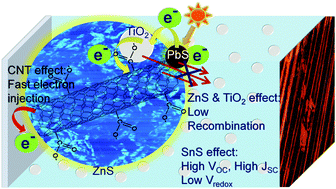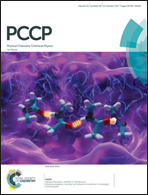Solar cells with PbS quantum dot sensitized TiO2–multiwalled carbon nanotube composites, sulfide-titania gel and tin sulfide coated C-fabric†
Abstract
Novel approaches to boost quantum dot solar cell (QDSC) efficiencies are in demand. Herein, three strategies are used: (i) a hydrothermally synthesized TiO2–multiwalled carbon nanotube (MWCNT) composite instead of conventional TiO2, (ii) a counter electrode (CE) that has not been applied to QDSCs until now, namely, tin sulfide (SnS) nanoparticles (NPs) coated over a conductive carbon (C)-fabric, and (iii) a quasi-solid-state gel electrolyte composed of S2−, an inert polymer and TiO2 nanoparticles as opposed to a polysulfide solution based hole transport layer. MWCNTs by virtue of their high electrical conductivity and suitably positioned Fermi level (below the conduction bands of TiO2 and PbS) allow fast photogenerated electron injection into the external circuit, and this is confirmed by a higher efficiency of 6.3% achieved for a TiO2–MWCNT/PbS/ZnS based (champion) cell, compared to the corresponding TiO2/PbS/ZnS based cell (4.45%). Nanoscale current map analysis of TiO2 and TiO2–MWCNTs reveals the presence of narrowly spaced highly conducting domains in the latter, which equips it with an average current carrying capability greater by a few orders of magnitude. Electron transport and recombination resistances are lower and higher respectively for the TiO2–MWCNT/PbS/ZnS cell relative to the TiO2/PbS/ZnS cell, thus leading to a high performance cell. The efficacy of SnS/C-fabric as a CE is confirmed from the higher efficiency achieved in cells with this CE compared to the C-fabric based cells. Lower charge transfer and diffusional resistances, slower photovoltage decay, high electrical conductance and lower redox potential impart high catalytic activity to the SnS/C-fabric assembly for sulfide reduction and thus endow the TiO2–MWCNT/PbS/ZnS cell with a high open circuit voltage (0.9 V) and a large short circuit current density (∼20 mA cm−2). This study attempts to unravel how simple strategies can amplify QDSC performances.



 Please wait while we load your content...
Please wait while we load your content...